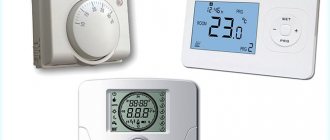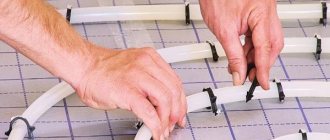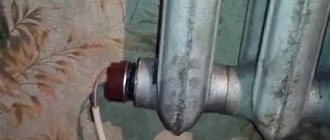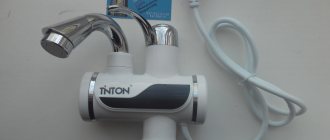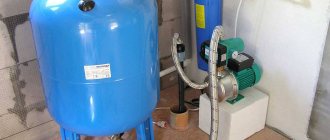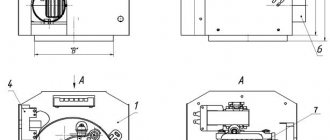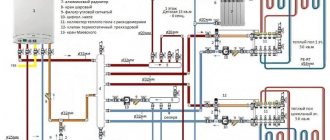To provide a private or country house with hot water if there is a double-circuit boiler in the building, an additional connection to the water heater boiler is often required. If the boiler has not yet been installed, then the best option would be to buy a single-circuit boiler, to which an indirect heating boiler is connected, but in a situation where the house has a 2-circuit boiler and it cannot be replaced with a single-circuit one, you should correctly connect an additional water heating device to it.
Materials
To arrange hot water supply in this way, you need to prepare:
- Boiler
- Circulation pump
- Double-circuit thermoblock
Connection diagram
The heating circuit of the water heater is looped with the second heat exchanger of the gas boiler. In this case, the incoming pipe of the heater is connected to the first pipe of this boiler heat exchanger, and the outlet pipe of the boiler is connected to the second pipe. Water from the water supply will no longer enter the boiler heat exchanger, but into the boiler, and from there enter the hot water supply system.
If an electric boiler is connected to a double-circuit boiler, the circuit will be almost the same. In this case, the water supply network is connected to the first pipe from the second heat exchanger, and its second pipe is connected to the boiler. A pipe runs from the electric heater to the mixers, through which hot water will flow.
Stages of work
- The first step will be installing the boiler. The heater must be installed in close proximity to the heating boiler. This is important for linking these devices with the desired automatic device.
- The second stage of work consists of combining the boiler and the boiler into a common scheme. For proper operation, the heater should not absorb most of the heat, as this will lead to problems with heating the house. The optimal solution is to install a circulation pump that has automation.
- The final step is connecting the thermoblock.
Approximate cost of work
Work on connecting any water heating device to a gas boiler should be entrusted to professionals. The cost of their services will depend on the actions required. For example, designing a boiler room costs from 300 rubles, for installation of a boiler you need to pay from 3,000 rubles, and for installing a pump group - at least 3,300 rubles.
In the following video you can see how to properly connect a contour boiler to an indirect heating water heater.
Hello to you, my reader! I dedicate this post to an interesting question that different people periodically ask me. This question sounds like this: “I heard that you can connect a storage water heater to a double-circuit boiler and not buy an indirect heating boiler. Is it true?" I will say right away that such a scheme exists. Let's figure out together why all this is needed.
Why connect a water heater to a double-circuit boiler?
In summer, the double-circuit boiler does not work to maintain the required temperature in the rooms. It is switched to a special “summer” mode, in which only hot water supply works. When a flow appears through the heat exchanger, the burner turns on. Often, a characteristic pop is heard due to the ignition of gas in the combustion chamber. Listening to these claps all day is below average pleasure, and it’s unnecessary stress for the boiler. To solve this problem, a scheme for connecting a storage water heater to the hot water supply circuit of the boiler was invented. A storage water heater acts as a battery in which hot water is stored.
Schemes for connecting a water heater to a gas boiler.
Now let's move on to considering the diagram for connecting the water heater to the DHW circuit of the boiler. So, look at the picture below:
The figure shows that the storage water heater is connected separately to the boiler and to consumers. The separation is done using two three-way valves with servo drives. Switching the servos and turning on the circulation pump is carried out by a device called a “power control circuit”. This device is connected to the water heater thermostat. There are no standard solutions here and you will have to invent this device from scratch.
For comparison, I will give you another diagram from the technical document:
There are no three-way valves and no power management circuitry in this circuit. The circulation pump is powered directly through the water heater thermostat. This is done according to the following scheme:
The upper diagram has one important feature - the water heater there has three connection pipes. This is a non-standard option for electric water heaters, but indirect heating boilers have a recirculation input and output, through which it is quite possible to organize a similar connection scheme. Well, for ordinary electric water heaters we will again have to invent something. Sometimes such a “collective farm” takes a lot of time, effort and money.
Now let's understand how water circulates in the upper circuit. To do this, I will give two more pictures:
In the upper figures, arrows indicate the direction of water circulation in each operating mode. In this scheme, heating and water withdrawal can occur simultaneously.
Three options for connecting a boiler to a double-circuit gas boiler or water heater
1. There is an option to purchase an indirect heating boiler , with a heat exchanger inside, and connect it to the heating circuit of a double-circuit boiler. But the cost of such a boiler and additional equipment for its connection and piping is quite high.
2. I recommend installing a layer-by-layer heating boiler . This boiler does not have a heat exchanger, which significantly reduces its cost.
3. Or, in the DHW circuit, between the double-circuit boiler (column) and hot water consumers, install an electric boiler . This option does not eliminate all the shortcomings of the hot water system, but it can significantly improve the comfort of using water.
The easiest way to improve a hot water system with a double-circuit gas boiler or water heater is to install an electric storage water heater - an electric boiler.
Connection diagram for an electric hot water boiler to a double-circuit gas boiler, as a storage buffer tank between the boiler and consumers. The water pressure in the water supply is no more than 6 bar.
An electric boiler is used as a buffer tank between the boiler and hot water consumers. From the DHW circuit of a double-circuit boiler, hot water enters the electric boiler before reaching the consumer. Hot water is supplied to the water taps from the boiler.
An electric boiler is used to store a supply of hot water heated by a gas boiler. In addition, the temperature of the water in the boiler is maintained at a given level by turning on the electric heating element. The inclusion of the electric heater is controlled by the boiler thermostat.
In the diagram, on the water supply pipe from the boiler to the boiler, a block of two valves is installed - a check valve and a safety valve. Valves are usually sold complete with an electric boiler.
The non-return valve prevents water from leaving the boiler when the water in the water supply disappears.
The safety valve relieves excess pressure from the hot water system due to the expansion of water when heated. A small amount of water periodically leaks from the valve , which must be disposed of somewhere.
In addition, the electric boiler manufacturer prescribes regularly, every two weeks, checking the serviceability of the valve by manually actuating it. In order to avoid these problems, I recommend additionally installing an expansion tank for DHW , which will compensate for changes in water pressure in the DHW system.
The DHW circuit with an electric boiler is somewhat popular due to its simplicity and lower cost. There is no circulation pump in the circuit; you can use a regular electric boiler; the amount of fittings for piping is also minimal. But operating a DHW system with a buffer electric boiler has its drawbacks.
Advantages and disadvantages of a hot water supply system with a buffer electric boiler
The DHW circuit with a buffer electric boiler ensures a stable water temperature at the outlet to consumers, including at low water consumption and when the boiler is clocked. The water temperature in the boiler can be set above 60 ° C (the temperature produced by the boiler). Using hot water will become more comfortable, but you will have to pay for it with higher electricity consumption.
The circuit with a buffer electric boiler has three main disadvantages.
Firstly, this is a fairly significant consumption of electricity for heating water. Electricity is spent to compensate for heat losses (water cooling) when storing hot water in the boiler, as well as to heat that part of the water that flows from the boiler into the cold boiler.
Some of the water from the boiler enters the boiler cold. This happens during the start of the boiler’s DHW mode each time the water tap is opened, as well as in the case of boiler cycling. In addition, cold water from the boiler is supplied to the boiler in case of insignificant hot water consumption, when the flow rate is less than the minimum threshold required to start the boiler in DHW mode.
Electricity is also spent on heating water if the boiler thermostat is set to a temperature above 60 °C.
The second drawback is that the boiler’s DHW mode is still turned on every time the water tap is opened. Boiler clocking is not eliminated, but only becomes invisible to the consumer. All this, as mentioned above, reduces the boiler’s operating life, and frequent re-ignition of the burner reduces the efficiency of the boiler and increases gas consumption.
Thirdly, the dependence of pressure in hot water pipes on water flow remains , since water from the water supply continues to pass through the flow limiter in a double-circuit boiler or column. For this reason, when the second water tap is opened, the temperature of the water in the first mixer may change, although not so much.
At the end of this article you will find a DHW diagram with an electric boiler and hot water recirculation , as well as recommendations for choosing equipment.
A hot water supply system with a double-circuit boiler (or column), but with a layer-by-layer heating boiler eliminates all the disadvantages.
| DHW diagram with layer-by-layer heating boiler and instantaneous water heater |
Recently, a hot water supply system with a layer-by-layer heating boiler has been gaining popularity,
the water in which is heated by a flow-through water heater. This boiler does not have a heat exchanger, which reduces its cost.
Hot water is drawn from the top of the tank. In its place, cold water from the water supply immediately flows into the lower part of the tank. The pump drives water from the tank through a flow-through heater of a gas boiler or water heater, and supplies it directly to the top of the tank. Due to this, the consumer gets hot water very quickly
— you don’t need to wait until almost the entire volume of water warms up, as happens in an indirect heating boiler.
Rapid heating of the top layer of water allows you to install a smaller boiler in the house, as well as reduce the power of the flow-through heater,
without sacrificing comfort.
Manufacturers produce double-circuit boilers with a built-in or remote layer-by-layer heating boiler. As a result, the cost and dimensions of the DHW system equipment are somewhat smaller,
than with an indirect heating boiler
The water in the boiler is heated in advance,
regardless of whether it is spent or not. The hot water reserve in the tank allows you to use hot water in the house for several hours.
Thanks to this, the water in the tank can be heated for quite a long time, gradually accumulating thermal energy in the hot water.
The long duration of water heating allows the use of a relatively low power heater.
Schematic diagram of connecting a layer-by-layer heating storage boiler to a double-circuit boiler
In the diagram, arrows show the direction of water movement in the DHW circuit of the boiler during operation of the circulation pump. The pump is turned on by the temperature sensor, boiler thermostat.
The circulation of water in the DHW circuit of the boiler starts the boiler in DHW mode. The water heated by the boiler enters the boiler, where it rises. Cold water from the bottom of the boiler is pumped into the boiler. This continues until the water in the boiler heats up until the boiler temperature sensor is triggered. The sensor turns off the pump, water circulation in the heating circuit stops and the DHW mode of the boiler is switched off.
Hot water to the water taps comes from the top of the boiler through a separate pipe. This solution makes it possible by simple means to stabilize the temperature of the water that goes to the consumer. When hot water from the boiler is consumed, it is replaced by cold water from the water supply.
The water circulation rate in the DHW circuit of the boiler is selected so that the water in the boiler has time to heat up to the set temperature quickly enough so that consumers do not experience discomfort. To do this, it is convenient to install a pump that allows you to switch the operating speed.
How to connect a boiler to a wall-mounted boiler
- Video author: Marat Ishmuratov
- Author's channel: https://www.youtube.com/channel/UCyrdKMbXbRXONaCrEY0rnPg
- Video:
The topic of this article is wall-mounted gas boilers and indirect heating boilers. Let's look at how they work together, as well as possible options for connecting them.
- The first option for connecting the boiler
So, the first connection option is when the wall of a gas single-circuit boiler initially already has outputs for connecting an indirect heating boiler.
If you look at the boiler from below, it will somewhat resemble an ordinary double-circuit boiler, but according to the passport it is listed as a single-circuit wall-mounted gas boiler.
If you look at the diagram of this boiler, we will see that it has one pipe - supply to the heating system, the second - supply to the boiler, as well as pipes for gas inlet, return from the boiler and return from the heating system. Also, this boiler already has a built-in three-way valve with an electric drive.
Let's look at how it all works. Since the boiler already has ready-made outlets, we immediately connect our boiler directly to the boiler.
Next, we connect the heating circuit to our boiler. Let's say it's winter outside and the heating is running at full capacity.
The boiler is turned on and heats the coolant along this circuit:
Radiators or heated floors heat up - this, in principle, does not matter. The boiler heats the house. Let's say that our boiler, which has a power of 24 kW and maintains a temperature of 50 °C, uses 15 kW of thermal power. At some point, through a temperature sensor installed directly on the boiler itself, the boiler receives a request to heat the boiler.
After this, the boiler automation commands the three-way valve to switch from the heating circuit to the boiler heating circuit.
The supply of coolant to the heating system stops, and it begins to flow into the boiler heat exchanger to heat household water. At the same time, the burner on the boiler starts at full power, 24 kW, and the temperature is maintained at a maximum level of about 80 °C.
This is necessary in order to quickly heat the water in the boiler to the desired temperature. When the hot water in the boiler is completely heated, the boiler automation switches to the heating circuit through the same temperature sensor. Let’s assume that before this the coolant temperature was set to 50 °C. This requires only 40% of the burner power. Let's look at how this system works in the summer when the heating is turned off. We switch the boiler to summer mode; most of the time it does not work, but is in standby mode. As soon as the boiler automation system receives a signal that the boiler needs to be heated, the boiler starts up, turns the burner to full power, 24 kW, and the coolant temperature at the boiler outlet is again maintained around 80 °C.
After the hot water in the boiler is completely prepared, the boiler turns off completely and goes back into standby mode.
- Second option for connecting the boiler
Let's look at another connection option, also with a wall-mounted gas boiler. Its only difference is that the boiler does not have any possibility of initially connecting an indirect heating boiler. Unlike the first option, this boiler does not have a built-in three-way valve, so we will have to install it separately.
It looks something like this and is installed at the outlet of the boiler. After this, we connect the boiler and heating circuit to the boiler.
To control the three-way valve, we connect an electric drive to the automation of the wall-mounted boiler. The temperature sensor from the boiler is still connected to the boiler.
Further, the operation of the boiler is, in principle, no different from the operation shown in the first option. When the boiler is operating in heating mode, there is no circulation through the boiler heat exchanger. As soon as a request is received from the boiler to heat water, the boiler automation switches the external three-way valve, and all the coolant from the boiler flows only to the boiler heat exchanger.
With the first and second connection methods, we can set the temperature that needs to be maintained in the boiler directly on the boiler.
Some boilers have a very useful feature called “anti-legionella”. Let's say in the summer we maintain the temperature in the boiler at around 45 °C, but from time to time the boiler in the boiler heats the water to 65 °C to kill legionella.
- The third option for connecting a boiler, its pros and cons
Let's look at the third connection option. In this case, there is also a single-circuit wall-mounted boiler without the possibility of connecting a boiler. We will consider connecting an external boiler using the example of pumping groups from the Meibes company.
In this case, the boiler will be connected through a hydraulic valve to three independent separate circuits with separate pumps.
Let's say this is a radiator circuit, a heated floor circuit and a boiler. Let's look at how the system works. Let's say we only need to heat the radiator and heated floor.
In this case, the boiler drives the coolant into the hydraulic valve, and through the distribution manifold the coolant is taken by pumps for radiators and heated floors.
After a request to heat the boiler is received, the boiler automation turns off the pumps that go to the radiators and the heated floor. The coolant circulation stops there and the pump turns on, which only heats the boiler.
Thus, all the coolant that comes from the boiler circulates only through the boiler circuit. At the same time, the burner in the boiler is started at full power, and the outlet temperature is maintained around 80 °C.
Thus, the boiler heats up quickly, literally in 10 - 15 minutes.
After this, the boiler automation turns off the circulation pump, which goes to the boiler, then turns on the pumps again, which go separately to heating the house, and the boiler burner also goes into normal operation. In the summer, when our heating is turned off, the boiler is also turned off and starts only when the boiler needs to be heated.
If the boiler automation does not allow you to control external pumps, you can install a separate controller, which itself can control both the boiler and individual circuits.
One may ask: why turn off the pumps that go to heating before heating the boiler? Simply turn on the boiler loading pump and add burner power. And you don't need to use any complex automation.
But in practice, unfortunately, this does not work out that way. Let's say that our house has an area of approximately 200 m² and a boiler with a capacity of 24 kW. We need all the boiler power for heating and heating the boiler. The heating circuit requires on average approximately 12 - 16 kW. Thus, if our boiler works simultaneously for both heating and the boiler, the boiler will receive about 8 kW. Let's say the boiler volume is 150 liters and the heat exchanger of this boiler has a power of approximately 24 kW.
If we only heated a boiler without heating with a boiler, it would warm up in about 15 - 20 minutes.
But if the boiler works both for heating and for the boiler, it will turn out differently. Let’s say our power is divided in half, 12 kW. In this case, the boiler will heat up much longer - from 60 to 80 minutes, and maybe even longer.
There is one more nuance. Any boiler must produce hot water in a duct - when the boiler completely runs out of heated hot water, it must still continue to produce hot water in a duct of about 12 - 14 liters per minute.
If the boiler heat exchanger gets only 12 kW, then the water in the flow will be about 6 liters per minute, and maybe 4 liters per minute.
You can, of course, get out of this situation differently - take a wall-mounted boiler with a good power reserve, about 50 kW. But where can you get such a powerful wall-mounted boiler? Is it possible to install an ionization one? But it will be three times more expensive. You can also try installing a floor-standing boiler and equipping it with a separate pump and an expansion tank with a safety group.
Let it also have a good power reserve of 50 kW.
We don’t need automation in this case either. We will have to set the temperature on the boiler to approximately 80 °C so that it maintains it constantly.
But the most interesting thing is that for warm floors, 40 °C would be enough for us; for radiators, as a rule, 60 °C is enough.
(Figure 41)
It turns out that we only need such a high temperature to warm up the boiler. Considering that the boiler heats up quite quickly, and we do not use hot water around the clock, we can say that most of the time such a high temperature will remain unclaimed.
To summarize, let’s say that of the three connection options listed above, the most optimal is the first one, where the boiler already has a built-in three-way valve, and the boiler automation is already configured to connect the boiler. If you use this connection option, you will not encounter any problems during connection and operation of the boiler.
Connecting a boiler to a double-circuit gas boiler
The Galmet SG (S) Fusion 100 L stratified heating boiler (for double-circuit boilers) has a built-in three-speed circulation pump. Boiler height 90 cm, diameter 60 cm.
On sale you can find layer-by-layer heating boilers specifically designed for connection to a double-circuit boiler. For example, the figure shows a diagram of connecting a boiler made in Poland to a boiler.
Thanks to the technology of layer-by-layer heating of water with the accumulation of hot water in the boiler, the number of boiler starts is reduced, which extends its service life and reduces gas consumption.
Uniform water temperature (without sudden changes) ensures comfortable use of water at more than one tap point .
The boiler has five pipes for connecting external pipelines. Moreover, the ends of the pipes inside the boiler are at different heights. Such a large number and arrangement of pipes allows the boiler to serve as a hydraulic separator. This solution eliminates the mutual influence on the circulation mode and water temperature in different circuits of the system and makes it easier and cheaper to connect equipment with fittings.
For example, two pipes are intended for the hot water recirculation circuit in the distribution pipes around the house. The waiting time for hot water will not depend on the length of the pipes to the water collection point. The DHW heating circuit of the boiler is connected to the other two pipes. For cold water from the water supply there is also a separate pipe.
An expansion tank and a safety valve are connected to the cold water supply pipe from the water supply system, and a check valve is also installed (not shown in the diagram).
A floor-standing boiler is also good because dirt and sludge settles and accumulates at the bottom, does not get into the pipes and does not affect the operation of the equipment.
Choosing an electric boiler for a hot water supply system with a double-circuit boiler or water heater
To get the benefits of using hot water from a hot water system with a boiler and an electric boiler, it is enough to install a small-capacity boiler, 15-30 (50) liters. In addition, a small boiler will consume less electricity than a large one.
I recommend choosing an electric boiler with a cylindrical stainless steel tank. The boiler is often installed next to the boiler or water heater. To ensure that the dimensions of the boiler do not go beyond the dimensions of the boiler, it is convenient to use electric water heaters with a vertical tank of small diameter. The brand name of such boilers usually contains the word Slim .
I recommend, Thermex Ultra Slim IU 30 (or 50) V has a stainless steel tank, a metal body, three stages of heating element power 0.7/1.3/2.0 kW, a maximum outer diameter of 285 mm, and a height of 800 (1235) mm., mechanical control. Warranty - 7 years. The tank capacity is sufficient to use hot water, heated even without the participation of a boiler.
Budget option Termex Drift 15 U for 15 liters with a stainless steel tank, with one heating element power level of 1.5 kW. External dimensions 260x260 mm, height 458 mm. Thanks to the top connection , the boiler can be installed both on the wall and on the floor under the boiler .
READ How to connect a tablet to a car for diagnostics
Electric storage water heaters with a flat body shape should not be chosen. In the housing of flat water heaters, two cylindrical tanks of small diameter are installed side by side and connected to each other by pipes. Such a complex design creates problems with ensuring their durability, with the distribution of water temperature in the tanks, and also increases their price.
At the end of this article you will find a DHW diagram with a boiler and hot water recirculation , as well as recommendations for choosing equipment.
